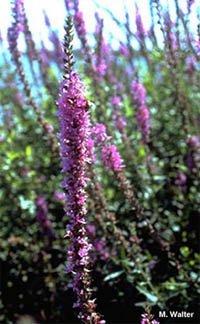 |
| Purple Loosestrife ( Lythrum salicaria ) PATHWAYS/HISTORY: This species is naturalized from Europe, first reported in the U.S. along the northeast coast in the early 1800's. Due to its attractive flowers, it has been planted as an ornamental garden species and has escaped from cultivation; it is now in at least 40 states and Canada. RISKS/IMPACTS: Often populations have spread so aggressively that native vegetation is excluded. Several garden races, some with larger rose-red petals, have been produced from this species and are cultivated. It is estimated that 200,000 ha of wetlands in the U.S. are lost annually through invasions of this species. MANAGEMENT: Hand pulling is an effective and selective way to remove purple loosestrife. It is best done while plant is in flower before it goes to seed (July or August). Cutting may be used to contain large populations of loosestrife by reducing stem numbers and seed production. A loosestrife-eating beetle (Galerucella) is sometimes used as a biological control. Herbicides must be used with extreme caution because herbicides are non-selective and will hurt the nearby vegetation. WHAT YOU CAN DO: Although you may find purple loosestrife available for sale, do not purchase or intentionally plant this species. If you have purple loosestrife growing in your yard, pull it out and replace it with native vegetation. PROFILE CREDIT: David Webb - IMAGE CREDIT: Martha L. Walter, Michigan Sea Grant |
HOME - ANS - TASK FORCE - PREVENTION - MONITORING - CONTROL - EDUCATION - RESEARCH  Copyright © 2005 - United States Federal Aquatic Nuisance Species Task Force - All Rights Reserved |
 DESCRIPTION
DESCRIPTION